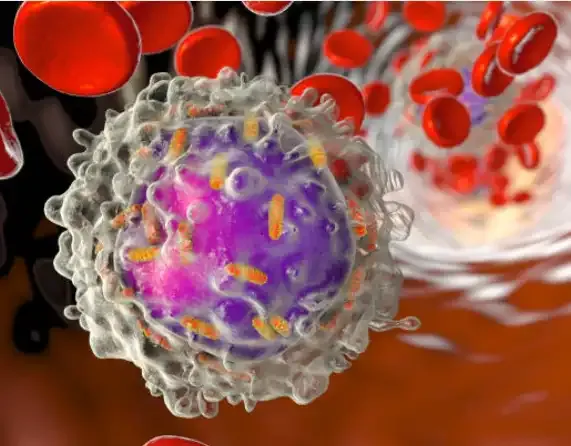Acute lymphoblastic leukemia (ALL), also known as acute lymphocytic leukemia, is a type of blood cancer that affects white blood cells called lymphocytes. It is characterized by the rapid and aggressive progression of immature blood cells in the bone marrow. While ALL can affect both adults and children, it is most commonly diagnosed in younger individuals. In this comprehensive guide, we will delve into the causes, symptoms, diagnosis, and treatment options for acute lymphoblastic leukemia.
Understanding Acute Lymphoblastic Leukemia
Acute lymphoblastic leukemia originates in the bone marrow, the spongy tissue inside bones responsible for producing blood cells. Normally, bone marrow produces stem cells that develop into three types of blood cells: red blood cells, which carry oxygen; white blood cells, which help fight infection; and platelets, which aid in blood clotting. In ALL, immature white blood cells, known as blast cells, are released into the bloodstream before they are fully developed.
As blast cells accumulate, the production of red blood cells and platelets decreases, resulting in symptoms such as pale skin, fatigue, and an increased risk of bleeding. Additionally, blast cells are less effective in fighting infections, making individuals with ALL more susceptible to frequent and severe infections.
Recognizing the Symptoms
The symptoms of acute lymphoblastic leukemia often start slowly but rapidly worsen as the number of blast cells in the blood increases. These symptoms are primarily caused by a deficiency of healthy blood cells. Common symptoms of ALL include:
- Pale skin
- Fatigue and breathlessness
- Repeated infections
- Unusual and frequent bleeding, such as bleeding gums or nosebleeds
- High temperature and night sweats
- Bone and joint pain
- Easy bruising and swollen lymph nodes
- Abdominal pain due to a swollen liver or spleen
- Unintentional weight loss
- Purple skin rash
In some cases, blast cells can spread to the central nervous system, leading to neurological symptoms like headaches, seizures, and blurred vision. If you or your child experience any of these symptoms, it is crucial to consult a healthcare professional for a proper diagnosis.
Seeking Medical Advice and Diagnosis
If you or your child present with symptoms associated with acute lymphoblastic leukemia, it is important to seek medical advice promptly. While these symptoms may not necessarily indicate ALL, it is essential to investigate and treat any underlying condition causing them.
To diagnose acute lymphoblastic leukemia, a healthcare provider will perform several tests, including blood tests, bone marrow aspiration and biopsy, and lumbar puncture to check for the presence of blast cells in the cerebrospinal fluid. These diagnostic procedures help determine the type of leukemia, assess the extent of the disease, and guide treatment decisions.
Unraveling the Causes
The exact cause of acute lymphoblastic leukemia remains unknown. However, certain risk factors have been identified, including:
- Previous cancer treatment: Individuals who have undergone certain types of chemotherapy and radiation therapy for other cancers may have an increased risk of developing ALL.
- Exposure to radiation: High levels of radiation exposure, such as those experienced by survivors of nuclear accidents, can increase the risk of developing acute lymphoblastic leukemia.
- Genetic disorders: Certain genetic disorders, such as Down syndrome, are associated with a higher risk of developing ALL.
Additionally, studies suggest that smoking and obesity may slightly elevate the risk of developing leukemia. It is important to note that most cases of acute lymphoblastic leukemia occur sporadically, without any identifiable risk factors.
Treatment Options and Prognosis
The treatment of acute lymphoblastic leukemia typically begins shortly after diagnosis due to the aggressive nature of the disease. The primary treatment modality for ALL is chemotherapy, which aims to kill leukemia cells in the bone marrow, restore the balance of blood cells, and alleviate symptoms.
The treatment journey usually comprises three stages: remission induction, consolidation, and maintenance. Remission induction focuses on eliminating leukemia cells and achieving a state of remission. Consolidation therapy aims to eliminate any remaining leukemia cells, while maintenance therapy involves regular doses of chemotherapy to prevent the return of leukemia.
In some cases, a stem cell transplant may be necessary to achieve a cure. This procedure involves replacing the patient's diseased bone marrow with healthy stem cells from a donor.
The prognosis for acute lymphoblastic leukemia varies depending on various factors, with age being a significant determinant. Younger individuals tend to have a better outlook, with over 90% of children aged 14 or younger surviving leukemia for five years or longer after diagnosis. However, the prognosis becomes less favorable as age increases.
Support and Resources
Dealing with a diagnosis of acute lymphoblastic leukemia can be overwhelming for both patients and their families. Fortunately, several organizations offer information, advice, and support. Leukaemia Care and Cancer Research UK are valuable resources that provide comprehensive information about ALL, treatment options, and coping strategies.
In conclusion, acute lymphoblastic leukemia is a rapidly progressing type of blood cancer that affects white blood cells. Understanding the symptoms, seeking prompt medical advice, and exploring treatment options are crucial for managing the disease effectively. While the exact causes of ALL remain unknown, researchers continue to study potential risk factors. With advancements in treatment modalities and ongoing support, individuals diagnosed with acute lymphoblastic leukemia can navigate their journey with hope and resilience.

